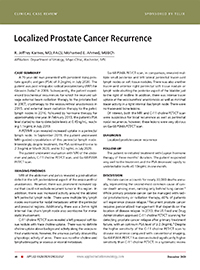To access the Case Studies, you must be a registered user of TelixU and logged in.
The case study content is frequently updated, therefore we encourage you to return often, to review the newly posted cases.
The PSMA PET/CT Case Studies provides the viewer with an opportunity to learn about the impact of PSMA imaging. Each case study demonstrates the potential clinical utility of 68Ga PSMA PET/CT. Knowing when to order the right imaging procedure at the right time can potentially provide better outcomes and positively impact the patient’s journey.
Combination Therapy Improves Efficacy in Widespread Prostate Metastatic Disease
Presented by:
Nat Lenzo, MMed, MSc(Oncol)

A 79-year-old man with prostate cancer previously treated in 1997 with radical prostatectomy and subse- quently treated with hormone therapy (ADT, abiraterone), chemotherapy (docetaxel, cabazitaxel), and strontium for metastatic bone disease presented in July 2017 with rising PSA levels.
The patient’s PSA levels rose from 764 ug/L on July 4, 2017, to 1,722 ug/L on Sept. 5, 2017, 1,950 ug/L on Sept. 25, 2017, to 2,481 ug/L on Nov.1, 2017, when gallium-68 (68Ga) PSMA-11 PET/CT scanning was performed.
PDF
|
Localized Prostate Cancer Recurrence
Presented by:
Mohamed E Ahmed, MBBCh | R. Jeffrey Karnes, MD, FACS

CASE SUMMARY
A 70-year-old man presented with persistent rising prostate specific antigen (PSA) of 3.2ng/mL in July 2020. The patient was post retropubic radical prostatectomy (RRP) for Gleason 3+4=7 in 2006. Subsequently, the patient experienced biochemical recurrences for which he received salvage external beam radiation therapy to the prostate bed in 2007, cryotherapy to the vesicourethral anastomosis in 2015, and external beam radiation therapy to the pelvic lymph nodes in 2016, followed by hormone therapy for approximately one year. In February 2019, the patient’s PSA level started to rise to detectable levels at 0.45ng/mL, reaching 1.1ng/mL in July 2019.
PDF
Text
|
Metastatic Castrate-Resistant Prostate Cancer (mCRPC)
Presented by:
Mohamed E Ahmed, MBBCh | R. Jeffrey Karnes, MD, FACS

CASE SUMMARY
A 69-year-old man presented with a persistent rising prostate specific antigen (PSA) of 15.8 ng/mL in September 2019. The patient’s previous PSA readings were 11.4 ng/mL in November 2018 and 12.9 ng/mL in May 2019.
The patient had a known history of prostate cancer and was treated initially with Radical Retropubic Prostatectomy (RRP) for Gleason 3 + 4 = 7. The patient subsequently experienced biochemical recurrences and was treated with salvage external beam radiation therapy, intermittent hormone therapy with leuprolide, and 3 cycles of Provenge.
PDF
Text
|
Recurrent Prostate Cancer
Presented by:
Nat Lenzo, MMed, MSc(Oncol) | Jaideep Sohi, MD | Tee-Sin Lim, MBBS, FRANZCR3

CASE SUMMARY
A 58-year-old man with a Gleason score of 4+5=9 prostate cancer underwent radical prostatectomy in January 2016. At the time of surgery, the cancer had progressed through the capsule and into the seminal vesicles. However, no nodes were involved. His post-operative prostate specific antigen (PSA) was 0.27 ng/ml. Patient was deemed at high risk for recurrence and was referred for salvage pelvic and prostatic bed radiotherapy in October 2016. A 68Ga PSMA-11 PET/CT was performed with no abnormal activity detected.
After radiotherapy, the patient’s PSA decreased from 0.58 ng/ml to nadir of 0.46 ng/ml and then spiked to 0.63 ng/ml in July 2017. Repeat 68Ga PSMA-11 PET/CT demonstrated no abnormal activity, and the patient entered an active surveillance program with repeat PSA tests every 3-6 months. At this time, the patient was not placed on hormone therapy or androgen deprivation therapy (ADT).
In March 2018, the patient’s PSA levels rose significantly to 2.9 ng/ml, necessitating a third 68Ga PSMA-11 PET/CT, which demonstrated PSMA-positive pathology. Patient received stereotactic radiotherapy to lymph nodes in the left internal iliac and right internal iliac stations. Active surveillance was again employed with no concomitant ADT.
PDF
Text
|
The Use of PSMA Targeted Therapy and Hormone Therapy in Renally Impaired Patient
Presented by:
Nat Lenzo, MMed, MSc(Oncol) | Jaideep Sohi, MD

An 82-year-old man presented with rising PSA of 21 ng/ml in July 2015. Prior to this time, in 2008, he received androgen deprivation therapy (ADT) and prostatic bed radiation (74 Gy). Patient was in Grade III renal failure with an eGFR of 30-40 ml/min and had previously undergone a laminectomy along with a history of osteoarthritis and lumbar stenosis.
In August 2015, the patient underwent a bone scan, which only detected degenerative changes. A CT scan found no evidence of metastatic disease. However, slightly prominent pelvic nodes of uncertain significance were noted and further evaluated with a 68-gallium (68Ga) PSMA-11 PET scan in September 2015. At the time of the PSMA PET scan, his PSA had risen to 29 ng/ml; it increased to 40 ng/ml the following month. At this time, the eGFR was 35 ml/min.
PDF
|